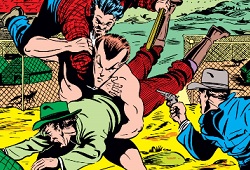
Art by Bill Everett
After Jim Hammond – the original Human Torch – was created by Carl Burgos in 1939, writer/artist Bill Everett was inspired to create his own superhero. Playing on the concept of “fire and water,” Everett conceived a character that was the antithesis of the Human Torch, the half-human, half-Atlantean Namor the Sub-Mariner.
Namor was originally scheduled to debut in a promotional comic published by Funnies Inc., a “packager” that supplied content for comic books in the earliest days of the medium. When the promotion never materialized, the initial tale of the Sub-Mariner was instead given to Timely Comics – the forerunner of today’s Marvel – for their inaugural publication Marvel Comics #1.
Namor the Sub-Mariner was an immediate success, becoming one of the most popular Marvel characters during the Golden Age of Comics alongside the Human Torch and Captain America. Unlike the other two superheroes, Namor was an antihero, often appearing as a nemesis despite having his own warped sense of justice. This changed, however, when the United States entered World War II and the Sub-Mariner fought alongside the Allies against Adolph Hitler and the other Axis powers.
It was after preventing a Nazi undersea invasion of the United States that Namor decided to take a break from his wartime heroics and visit the city of Seattle in Marvel Mystery Comics #27, published in January 1942. Although he was momentarily removing himself from the fight against the Nazis, that did not mean that the Sub-Mariner wasn’t looking for some action nonetheless.
“Maybe there’s a longshoremen’s strike, or a wharf brawl, or something that I can rip into,” he tells himself after arriving in Seattle’s harbor. “But first I’ve got to find some clothes to wear.” After scrounging around the dock, Namor first finds some discarded wharf-rat clothing and then encounters two unemployed stevedores – dock contractors who unload cargo ships – in the midst of a heated conversation.
“It ain’t fair, George,” one of them tells the other. “I tell ya, there’s sump’n gotta happen – but quick!”
Sensing trouble, Namor makes his way into the thick of it and asks what the two stevedores were talking about. “Us guys are all ‘brush-men,” the one named George replies. “We handle all the fur cargoes that ship in from Alasky – only lately there ain’t been no cargoes! Somebody’s smugglin’ pelts in, an’ sellin’ em’ tax-free, and ain’t nobody kin find out how it’s bein’ done. Sure ain’t comin’ in by ship, or we’d-a-knowed about it!”
After ruling out trains as well, Namor suggests that maybe the smugglers are using planes. George replies that the possibility had been considered but all of the landing fields are being watched and so far no one has noticed any illicit activity. Intrigued by the mystery, the Sub-Mariner discards his newfound clothes and once again launches himself into the Pacific Ocean to investigate further up the coast.
His journey takes him to the Alexander Archipelago, just off southeastern Alaska. Being mistaken as a tax collector in disguise, Namor is tipped off by a local farmer that he could find “ole Tez Coon” in the Thunder Cave hidden within the local mountains. Since the Sub-Mariner isn’t sure who or what he is searching for, he heads towards the Thunder Cave.
Namor is aware that the phrase “Thunder Cave” often refers to a cavern that contains running water that rumbles like thunder. Sure enough, he discovers an underground river and dives into it, only to be surrounded by a bevy of torpedoes speeding past him. Forced to dodge their onslaught, the Sub-Mariner grabs one and rips it open – instead of explosives, the torpedo is filled with furs.
“So this is how they’re being smuggled into the U.S.,” he realizes. “This underground channel must run clean down to some point in the state of Washington, and the capsules are picked up there. By golly, that is clever. I think I’ll just follow these gadgets and find out where they stop.”
For miles-upon-miles the Sub-Mariner follows the trail until the torpedoes suddenly stop dead in their tracks, caught within the field of a giant electro-magnet. An additional magnet, meanwhile, drops from above and redirects them to the surface.
Namor is now even more impressed by the operation, but his time for admiration is cut short when a small submarine roars past him and through a large steel door in the side of the coastline. The door slams shut before Namor himself can enter, but with his superhuman strength he is able to rip it open nonetheless.
After subduing two guards on the dock inside, Namor finally comes face-to-face with the mastermind behind the smuggling operation – Jasper Whifflegrass, also known as the Fox. Whifflegrass operates a farm in the lower mountains of the Alaskan coast range, and instead of paying taxes on his furs, he set up the operation that Namor has uncovered.
He was also in the mini-submarine that Namor followed, making a surprise visit to inspect his operation. Upon seeing the Sub-Mariner, however, Whifflegrass quickly re-enters the submarine and attempts to escape rather than risk a confrontation. Namor follows him back to the Whifflegrass farmhouse, where he then easily subdues the smuggler.
“Get me the U.S. Customs House,” Namor tells the operator, using Jasper Whifflegrass’ phone. “This is the Sub-Mariner. I’ve caught your fur tax evaders – come and get ‘em!”
And with that, Namor the Sub-Mariner’s adventures along the Pacific Northwest coastline comes to an end. His actual trip to Seattle may have been cut short, but it was still the first visit by a comic book superhero to the region nonetheless – making Namor a momentary Seattle Mariner in addition to the famed Sub-Mariner.
Anthony Letizia

